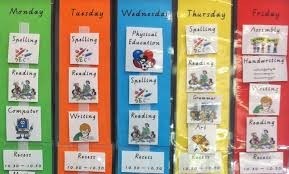TEACHH - Scheduling
A schedule or visual timetable shows the child with autism what to do and when it is to happen during the day, week or month (depending on the age and ability of the child).
Timetables can be displayed from top to bottom or left to right.

Visual cues are essential for children with autism; they also help children with speech, language and communication difficulties, learning difficulties, high anxiety, EAL etc. so are a must for any classroom. Visual timetables help children to understand what has happened and what is going to happen.
Consider the following when using your timetable:
- its position in the room
- when you will discuss it with the children to ensure it is given an appropriate level of importance
- how much information to display at one time
- whether you will use a ‘finished’ pocket for pictures of completed activities (which helps the children to visualise time passing)
- whose responsibility it will be to ensure the correct symbols are displayed each day
- whose responsibility it will be to ensure you stick to the activities displayed on the timetable OR if adaptations are needed to the routine who will make sure the symbols are altered accordingly
- where you will keep the symbols so that everybody knows where they can find spare ones
- how often you will review its use as a staff group
A visual timetable can be whole class and/or individual, depending on the needs and ability of the child. For young children the visual timetable should not be too lengthy or complex, covering only the main activities of the morning/afternoon. Further support and detail can be added by using generic symbols, e.g. ‘choosing time’. This can be followed up by guiding the child to check a ‘choice board’ to support him/her to engage in constructive play at non-structured times.
Related links

